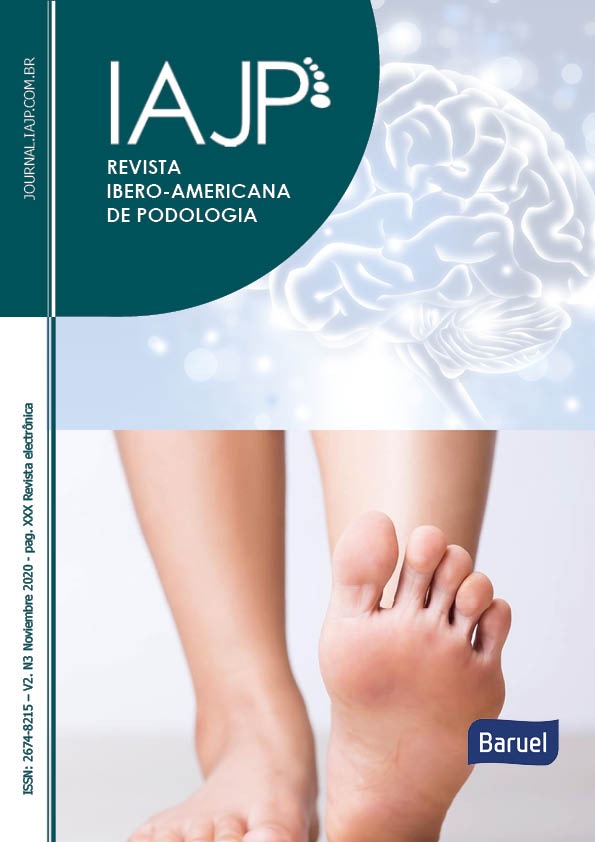O uso do ácido tricloroacético para avulsão química de unhas com onicomicose. Relato de caso
Main Article Content
Abstract
Objective: To describe the use of trichloroacetic acid 90% (90% ATA) as a chemical adjuvant for avulsion of nails with onychomycosis, verifying risks and benefits to the patient. Method: This is a case report study, in which 26 individuals with a diagnostic hypothesis of onychomycosis participated. The nails were quantified, measured, photographed and classified into distal subungual onychomycosis and proximal subungual onychomycosis, according to the lunula involvement. The intervention consisted of mechanical avulsion of the contaminated nail plate and application of ATA 90% to the residual nail plate, on the exposed nail bed and nail region. On subjects' return, after 7 days, the effects of ATA 90% were observed. Results: ATA 90% did not cause the desired chemical effect of detachment of the nail plate, but it did cause the skin to peel in the areas where it was applied. The partial reduction in nail size was the result of the onychectomy technique with an appropriate instrument performed by the podiatrist. Conclusion: The mechanical avulsion of the nail and the peeling of the skin caused by ATA 90% can benefit the patient in the treatment of onychomycosis by improving the local appearance and motivating him to self-care and treatment. The podiatrist can assist the health team with the management of fungal contamination and with the education of patients.
Article Details

This work is licensed under a Creative Commons Attribution 4.0 International License.
This license allows others to distribute, remix, adapt and create from your work, even for commercial purposes, as long as they give you due credit for the original creation. It is the most flexible license of all available licenses. It is recommended to maximize the dissemination and use of licensed materials. Particularly with regard to the CC-BY license, it should be noted that, as it is the most open license type with regard to permissions and access, it is also the license that allows the use of content for commercial purposes. This means that third parties can make a profit from the work of others at any time without the creator having any control. View license summary | View the legal text
References
Nakamura R.; Baran R. Doenças da unha: : do diagnóstico ao tratamento [Internet]. Rio de Janeiro: Elsevier; 2018 [citado 05 de dezembro de 2020]. Disponível em: http://elseviersaude.com.br/wp-content/uploads/2012/09/2011-Baran-ESAMPLE.pdf.
Gupta AK.; Foley KA.; Mays RR.; Shear NH.; Piguet V. Monotherapy for toenail onychomycosis: a systematic review and network meta-analysis. Br J Dermatol [Internet]. 2019;182(2): 287-299. Disponível em: https://doi.org/10.1111/bjd.18155.
Ameen M.; Lear JT.; Madan V.; Mohd Mustapa MF.; Richardson M. British Association of Dermatologists' guidelines for the management of onychomycosis. Br J Dermatol [Internet]. 2014;171(5):937-58. Disponível em: doi: 10.1111/bjd.13358. PMID: 25409999.
Thomas J.; Jacobson GA.; Narkowicz CK.; Peterson GM.; Burnet H. Toenail onychomycosis: an important global disease burden. J Clin Pharm Ther [Internet]. 2010;35(5)497-519.
Roberts DT.; Taylor WD.; Boyle J. Guidelines for treatment of onychomycosis. Br J Dermatol [Internet]. 2003;148: 402-410. Disponível em : https://doi.org/10.1046/j.1365-2133.2003.05242.x
Lipner SR.; Scher RK. Onychomycosis: Clinical Overview and Diagnosis. J Am Acad Dermatol [Internet]. 2019;80(4):835-851. Disponível em : doi: https://doi.org/10.1016/j.jaad.2018.03.062
Grover C.; Bansal S.; Nanda S.; Reddy BS.; Kumar V.; Combination of surgical avulsion and topical therapy for single nail onychomycosis: a randomized controlled trial. Br J Dermatol [Internet]. 2007;157(2):364-8. Disponível em : https://doi.org/10.1111/j.1365-2133.2007.08014.x
Lai WY.; Tang WY.; Loo SK.; Chan Y. Clinical characteristics and treatment outcomes of patients undergoing nail avulsion surgery for dystrophic nails. Hong Kong Med J. 2011;17(2):127-31.
Ligia RBR.; Chiacchio ND. Manual de Conduta nas Onicomicoses Diagnóstico e Tratamento. In: Sociedade Brasileira de Dermatologia. Manual de Conduta. Rio de Janeiro: Sociedade Brasileira de Dermatologia; 2004: 191-201.
Pan M.; Heinecke G.; Bernardo S.; Tsui C.; Levitt J. Urea: a comprehensive review of the clinical literature. Dermatol Online J. 2013;19(11):203-92.
Gloor M.; Fluhr J.; Lehmann L.; Gehring W.; Thieroff-Ekerdt R. Do urea/ammonium lactate combinations achieve better skin protection and hydration than either component alone. Skin pharmacol phys. 2002;15(1):35-43. Disponível em https://doi.org/10.1159/000049387.
Becerro R.; Losa ME,; Cervera LA.; Fernández DZ.; Prieto JP. Efficacy of intraoperative surgical irrigation with polihexanide and nitrofurazone in reducing bacterial load after nail removal surgery. J Am Acad Dermatol. 2011: 64(2) 328-35. Disponível em; https://doi.org/10.1016/j.jaad.2010.01.011.
Fanous N.; Zari S. Universal Trichloroacetic Acid Peel Technique for Light and Dark Skin. JAMA Facial Plast Surg. 2017;19(3):212-219. Disponível em: https://10.1001/jamafacial.2016.1666.
Barreiros H.; Matos D.; Goulão J.; Serrano P.; Brandão FM. Using 80% trichloroacetic acid in the treatment of ingrown toenails. An. Bras. Dermatol [Internet]. 2013;88( 6 ): 889-893. Disponível em: http://dx.doi.org/10.1590/abd1806-4841.20132296.
Terzi E.; Guvenc U.;Türsen B,.; Kaya Tİ.; Erdem T.; Türsen Ü.; The effectiveness of matrix cauterization with trichloroacetic acid in the treatment of ingrown toenails. Indian Dermatol Online J. 2015;6(1):4–8. . Disponível em: https://doi:10.4103/2229-5178.148912.
André MS.; Caucanas M.; André J.; Richert B. Treatment of ingrowing toenails with Phenol 88% or Trichloroacetic Acid 100%: A Comparative, prospective, randomized, double-blind study. Dermatol Surg.2018;44(5):645–650. Disponível em: https://doi:10.1097/DSS.0000000000001499.
Nilforoushzadeh M.; Fariba J.; Mansour S.; Ansari N.; Hossein AS.; Heidari A. Autologous fibroblast suspension for the treatment of refractory diabetic foot ulcer. Indian J Dermatol Venereol Leprol; 2016, 82: 105-6.
Dewandre L. A química dos peelings e uma hipótese dos mecanismos de ação. In: Peeling Químico. RJ: Elsevier, 2007.
Brasil. Lei no. 16.763, de 11 de junho de 2018. Dispõe sobre o exercício da profissão de podólogo e dá outras providências. [texto da Internet]. São Paulo (SP): Governo do estado de São Paulo; 2018. [citado 2020 Dez 8]. Disponível em: https://www.al.sp.gov.br/norma/186612
Bodman MA.; Krishnamurthy K.; Onychomycosis. In: StatPearls [Internet]. Treasure Island (FL): StatPearls Publishing; 2020.

